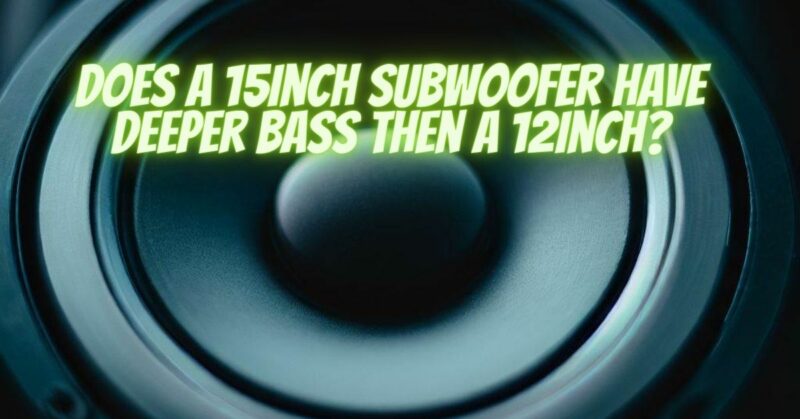When it comes to enhancing your audio experience, subwoofers play a vital role in delivering those spine-tingling, deep bass notes that can make your music, movies, and gaming truly immersive. One common question that arises among audio enthusiasts is whether a 15-inch subwoofer offers deeper bass than a 12-inch subwoofer. In this article, we will explore the factors that influence bass depth and help you understand the role of subwoofer size in achieving it.
Understanding Subwoofer Basics
Before we delve into the comparison, it’s essential to grasp some fundamental concepts about subwoofers.
Subwoofers are specialized speakers designed to reproduce low-frequency sound, or bass. They handle frequencies typically below 100Hz, providing the powerful thumps and rumblings that bring audio to life. The size of a subwoofer’s cone, measured in inches, affects its ability to produce deep bass notes. Smaller subwoofers tend to be more agile and responsive, while larger ones can move more air, potentially delivering louder and deeper bass.
The 15-Inch Subwoofer
Let’s begin by examining the characteristics of a 15-inch subwoofer and how they relate to bass depth:
- Size and Air Movement: A 15-inch subwoofer boasts a larger cone, which means it can move more air compared to a 12-inch subwoofer. This greater air displacement can potentially translate into deeper bass notes.
- Power Handling: Many 15-inch subwoofers are designed to handle more power, which can contribute to achieving lower frequencies with authority and precision.
- Suitable for Larger Spaces: If you have a large room or want to fill a spacious area with bass, a 15-inch subwoofer might be a better choice due to its capability to produce more significant sound waves.
The 12-Inch Subwoofer
Now, let’s explore the characteristics of a 12-inch subwoofer and how they impact bass performance:
- Size and Responsiveness: Smaller subwoofers like the 12-inch models can respond more quickly to changes in the audio signal, resulting in tighter and more accurate bass. They excel in reproducing punchy, mid-bass frequencies.
- Space Efficiency: If you have limited space or are looking for a subwoofer to fit in a compact car, a 12-inch subwoofer may be more practical.
The Role of Other Factors
While subwoofer size is a crucial factor, it’s not the only one that determines bass depth. Other factors such as subwoofer design, enclosure type, amplifier power, and equalization settings also play significant roles in shaping your subwoofer’s performance.
Which One Is Better for You?
Choosing between a 15-inch and a 12-inch subwoofer comes down to your specific needs and preferences:
- Room Size: Consider the size of the room or listening space. Larger rooms may benefit from the increased air movement and output of a 15-inch subwoofer.
- Music Preferences: Think about the type of music you enjoy. If you favor music genres with deep bass, a 15-inch subwoofer may provide a more satisfying experience.
- Space Constraints: Assess the available space for your subwoofer. If space is limited, a 12-inch subwoofer might be the more practical choice.
- Budget: Larger subwoofers often come with a higher price tag. Ensure that your budget aligns with your desired subwoofer size.
While a 15-inch subwoofer has the potential to produce deeper bass due to its larger cone size and power handling capabilities, the ultimate bass depth you achieve depends on various factors. A well-matched subwoofer, considering room size, music preferences, and budget, coupled with proper setup and calibration, will ensure a satisfying and immersive audio experience, regardless of whether you choose a 15-inch or a 12-inch subwoofer.


